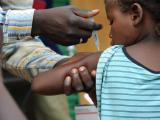Aug 16, 2006 (CIDRAP News) West Nile fever may not be the benign illness it's usually considered to be, according to findings from a North Dakota research group.
Patients who have had West Nile virus infections can continue to experience troubling symptoms, even a year after their illness, the researchers found.
The retrospective cohort study, published in the Sep 15 issue of Clinical Infectious Diseases, involved 49 patients who were identified through North Dakota's disease surveillance system. In 2003 when the disease had its largest spike in North America, North Dakota reported 617 cases.
The patients were assessed on average 13 months after they were diagnosed. Their medical records were reviewed, and they underwent a complete neurologic examination and took standardized surveys to determine their quality of life, functional ability, fatigue level, and depression level. Extensive neuropsychological testing was performed to gauge patients' cognitive function.
Of the 49 patients in the study, 11 (22%) had been diagnosed with West Nile meningitis or encephalitis and 38 (78%) had been diagnosed with West Nile fever. Fifteen (31%) of the patients had been hospitalized. The fever group included all of the nonhospitalized patients and four who had been hospitalized.
The most common complaints reported by patients were fatigue, memory problems, extremity weakness, word-finding difficulty, and headache. The surveys revealed an overall sense of poor health in 24 (49%) patients, fatigue in 24 (49%), depression in 12 (24%), and moderate to severe disability in 4 (8%). Ten patients (20%) reported new tremor. Neuropsychological testing showed abnormalities in motor skills, attention, and executive function. No significant associations were apparent between any of the patients' risk factors and the study findings.
The researchers emphasized the high prominence of fatigue among patients; 41 (84%) reported fatigue, and half of them had fatigue scores that resembled patients who have moderate to severe multiple sclerosis.
Paradoxically, patients who had more severe illness were not more likely than those with less severe illness to report more chronic symptoms. "On the contrary, some of the few statistically significant associations found in our study were higher rates of fatigue, word-finding difficulties, and excessive sleepiness in the nonhospitalized group of patients," they wrote.
Despite patients' persistent symptoms, most returned to a reasonable level of functioning and independence, the researchers noted.
They theorized that fatigue alone may not explain the patients' clinical and neuropsychological symptoms, which may be caused instead by subtle disease damage to the frontal-subcortical brain structures.
"This might suggest that West Nile fever is not a self-limited benign illness, as previously though, and may, in fact, be a subclinical encephalitis," the researchers wrote.
So far this year 388 cases of human West Nile virus infection have been reported to the Centers for Disease Control and Prevention (CDC). The total includes 13 fatalities.
According to the CDC, West Nile virus, a flavivirus, infected at least 2,949 people in 2005, causing 116 deaths. Although 80% of those infected will have no symptoms, about 20% will develop a fever, headache, tiredness, body aches, and, occasionally, a rash on the trunk. One in 150 patients develops severe neuroinvasive disease, such as encephalitis, meningitis, or poliomyelitis, according to the CDC.
Carson PJ, Konweko P, Wold KS, et al. Long-term clinical and neuropsychological outcomes of West Nile virus infection. Clin Infect Dis 2006 Sep 15;43(6):723-30 [Full text]
See also:
CDC West Nile virus 2006 cumulative case count

















